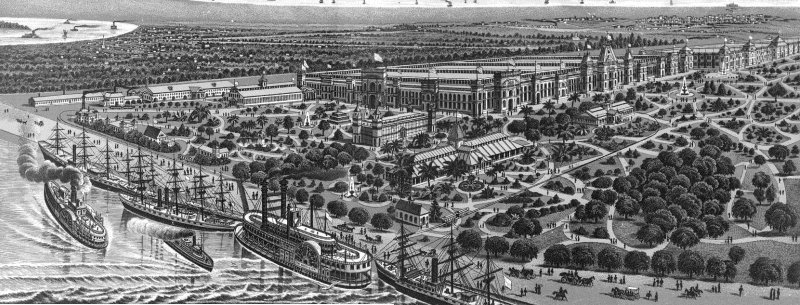Canal Street — Early New Orleans
Canal Street—at 170 feet six inches the widest business district street in the country—was never paved curb-to-curb for the use of ordinary vehicles. It originated as a “commons” area between the original city, also called the French Quarter or Vieux Carré, and the American Quarter, which grew immediately upriver. In the early 1800s, a canal was supposed to have been built down the middle of this commons, 50 feet wide, connecting the Mississippi River to the Basin Canal (also called the Carondelet Canal). The latter canal, now filled in, formed a connection to Lake Ponchartrain, running from Bayou St. John to Basin Street, where it ended in a large turning basin. The plan called for 60 feet of reservation on each side of the new canal. The proposed canal was never built, but the result was a 170 foot wide commons area, which gradually evolved into a street with two roadways flanking a central reservation. Source Like many of New Orleans’ wide main streets, this “neutral ground” (as New Orleanians call it) originally sported grass and trees, providing an almost park-like environment. Also like some of New Orleans’ other wide streets, part of this neutral ground eventually came to harbor street railway tracks, which were thereby considerably freed from conflict with other types of vehicles. But because Canal was (and remains) the center of the central business district, so many street railway lines used it that its wide neutral ground became completely filled with tracks, and was finally paved over. Even paved, though, the neutral ground was still for street railways only, and other vehicles remained in the two flanking roadways. Canal Street is what Downtown New Orleans is all about. Originally the dividing line between the French/Spanish “Creole” section of the city and the newer “American” Quarter, there indeed was a plan to put a canal in the middle of Canal Street, but that plan fell through in the 1830s. The street was still left at 170’ wide, however, making it a six-lane street with a large “neutral ground” (that’s “median” to those of you who didn’t grow up in New Orleans). Canal Street’s position and size made it Main Street New Orleans and the hub of the city’s transit system. Streetcars ran up and down the street’s neutral ground until 1964; this year, the New Orleans Regional Transit Authority began full service on a new Canal Street streetcar line in April. Source  Tripod |
